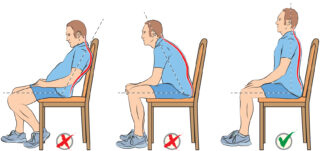
Active Care Chiropractic & Acupuncture
10680 Main Street
275
Fairfax, VA 22030

More Chiropractic Care Articles
Good Postures For Your Lower Back

Many questions arise frequently from patients who are concerned with daily postures like “How do I lie when I sleep?”, “Are there any tips when I drive for a long time?”, “What kinds of beds or mattresses do I need to buy?”, “ Is it better that I stand when I work with on a computer?” and “Do I need to change my chair or desk?”
It is not easy to give a simple answer for these questions because there are many factors that we need to consider including personal characteristics, individual health status, past medical history and more. Memory foam pillows could possibly have negative effects for one person while being a better choice for another. Therefore, it is always better that everyone receives expert advice with further evaluation.
In this article, we will cover some general information that we can advise without an individual evaluation or health status. We will first cover sitting postures due to the increase of sedentary lifestyles:
Sitting Postures
- It is better that the height of your chair matches your knee height.
- Firmer back cushions on your chair are generally better than soft cushions.
- Chairs without wheels are generally better than chairs with wheels.
- Sitting on the edge of your chair is not recommended.
- Sitting with legs crossed is not recommended.
- It is recommended to stand up from your chair with a short break every hour during prolonged sitting.
- Changing bad habits to correct old posture can be difficult but improving your sitting posture can be beneficial for everyone’s general health status.
Standing Postures
- It is always better to straighten your lower back without unbalanced positions. There are some additional recommendations including:
- Switch your body weight from one leg to another if you have to stand for a long time.
- It is better to rest one foot on a small stool and switch to the other frequently.
- It is better to wear comfortable shoes, not high heels.
- The above recommendations are for avoiding excessive pressure on one side of the body only.
Postures During Lifting Heavy Objects
- Spread the legs slightly.
- Bend both knees, not lower back.
- Keep the object close, toward the body.
- Do not twist or lift your body or trunk to the side.
- These lifting recommendations help to avoid any additional pressure on the lower back.
Postures For Sleeping
- Generally, “firm” is better than “soft”.
- Use a cushion or pillow under the knees while lying on your spine.
- Use a cushion or pillow between the knees while sleeping on your side.
As mentioned earlier, these are for general statements and recommendations. It is always better to get further evaluation from a specialist for specific or detailed advice. A specialist can help you create individualized recommendations that include considerable factors.
Other Articles You May Find of Interest...
- Experience the Refreshing Rewards Of Optimal Hydration This Summer
- Chiropractic Care 101: Benefits, Types, and Safety
- Chiropractic and Exercise For Optimal Health
- Long-Term Benefits of Regular Chiropractic Care for Pain Relief
- Chiropractic Treatment and Pain
- Essential Tips To Safeguard Your Back During Lifting
- Chiropractic Care For Your Child

















